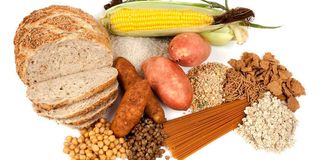Simple ways to boost your fibre intake

High fibre foods such as fruits and vegetables tend to be lower in calories.
What you need to know:
- Fibre intake affects your gut and digestion, immune system, appetite, mood, and more, so keep these tips in mind to make sure you are getting enough grammes per day for optimal wellbeing and health.
Fibre is a type of carbohydrate that the human body cannot digest. Despite the fact that most carbohydrates are broken down into sugar (glucose), fibre cannot be broken down in the same manner by human digestive enzymes.
High fibre foods can improve your digestion, reduce cholesterol, lower blood sugar, remove harmful toxins, decrease the risk of breast and colon cancer and help prevent and treat diabetes and heart diseases. People need about 30g of fibre daily.
There are two main kinds of fibres; soluble and insoluble. Soluble fibre dissolves easily in water, forming a gel-like substance that slows digestion, softens stools and improves elimination.
Insoluble fibre does not dissolve in water, but passes directly through the digestive system pretty much intact. This increases stool bulk, keeping bowel movements regular and eliminates constipation.
Food sources of dietary fibre are divided according to whether they provide soluble or insoluble fibre. Plant foods contain both types of fibre in varying amounts. The bulking fibres absorb and hold water, while the viscous thicken the faecal mass.
Soluble fibre is found in all plant foods, including vegetables such as broccoli, carrots and artichokes and root tubers such as sweet potatoes and root vegetables. Others are nuts with almonds which have the highest dietary fibre; seed husks; flax seeds; legumes such as peas, soybeans and other beans; oats, rye, chia, and barley, fruits such as figs, avocados, plums, prunes, berries, ripe bananas, and the skin of apples and pears.
Leave peels/skin on fruits/vegetables
Sources of insoluble fibre include vegetables such as green beans, cauliflower, zucchini and celery; some fruits such as avocado, and unripe bananas; the skins of some fruits such as kiwi, grapes and tomatoes, whole grain foods, wheat and corn bran, legumes such as beans and peas, nuts and seeds as well as potato skins.
How to ensure adequate dietary intake of fibre? Leave the peels or skin on fruits and vegetables. When you peel fruits and vegetables such as apples, baby potatoes and cucumbers, you remove half of the fibre they contain.
Ensure you have a lot of legumes in your diet. Beans, dried peas and lentils are the most common type of legumes that constitute an important part of many traditional diets. Replacing meat with legumes in a few meals per week is linked to increased life span and a decreased risk of several chronic diseases.
To increase the consumption of legumes, you can add them to ground/mashed dishes as well as salads.
Food labels
Always check food labels to see how many grammes of fibre are indicated for each serving. More than 2.5 grammes per serving is considered a good source, while five grammes or more is excellent.
Whole plant foods are usually the best sources of fibre. If you purchase processed foods, check the food labels to choose products that are rich in fibre.
Some processed foods have functional fibres extracted from natural sources. Fibre names used on food labels include inulin and polydextrose.
Strive to eat high-fibre foods at each meal, including snacks. Choose a high-fibre cereal or oatmeal and add berries and seeds for your breakfast. Eat or pack to school or work raw vegetables or raw fruits for your snack time.
Nutritious and rich in fibre
● If you choose to make a sandwich, use whole-grain bread. Have salads included in your lunch and dinner. Use nuts such as almonds and seeds in your recipes to make your meals more nutritious and rich in fibre.
● Avocados are rich in fibre, thus, use them as a spread instead of butter. Add it to salads also.
● Berries are rich in fibre and tend to have less sugars as compared to other fruits. You can diversify their consumption by incorporating them in your breakfast cereal and even salads. Add them in yoghurt for a healthy snack.
● Select whole grains instead of refined ones. The former are minimally processed. Beside oatmeal or brown rice, you can try out millet, quinoa, barley or amaranth.
● All fruits deliver fibre, although some have significantly more than others. Berries, apples and pears are high-fibre fruits.
● When baking, choose a flour that is rich in fibre. Replace white flour with whole-wheat option. Try out soy, coconut, almond, chickpea, buckwheat and barley flours.
● Seeds such as chia, flax and sesame are good sources of dietary fibre. They should be incorporated in various recipes as well as sprinkled on salads.




